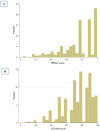Linking health-related quality of life to labor supply: a study of nurses in Western Iran
- PMID: 40442649
- PMCID: PMC12123833
- DOI: 10.1186/s12912-025-03284-6
Linking health-related quality of life to labor supply: a study of nurses in Western Iran
Abstract
Background: Understanding the relationship between health-related quality of life (HRQoL) and labor supply is essential for developing effective policies to improve nurses' working conditions. Therefore, this study seeks to evaluate the HRQoL of nurses and explore how HRQoL influences their labor supply.
Methods: In this cross-sectional study, data were collected from 577 nurses working in seven public hospitals in Kermanshah city through multistage sampling. Data collection was conducted using a two-part self-administered questionnaire from September 20 to November 15, 2024. The first section aimed to gather information on nurses' labor supply and included 22 items related to sociodemographic, economic, and non-economic factors. The second section comprised the EuroQoL 5 dimensions (EQ-5D) with a five-level scoring system and the EuroQoL visual analog scale (EQ-VAS). A multiple linear regression model was employed to explore the association between HRQoL scores and nurses' labor supply among the study participants.
Results: The study found that the average weekly working hours for nurses across all medical centers were 47.9 h, while the average at the main hospital was 45.9 h. The mean health-related quality of life (HRQoL) score among the nurses was 0.76 ± 0.23, and the average EQ-VAS score was 74.4 ± 18.9. Our study across the five dimensions of the EQ-5D-5 L indicated that the percentages of nurses reporting no problems were 78.2% for mobility, 97.1% for self-care, 81.3% for usual activities, 47.5% for pain/discomfort, and 37.4% for anxiety/depression. The analysis revealed a statistically significant positive relationship between HRQoL and the labor supply of nurses, indicated by a HRQoL score coefficient of 3.692 (p = 0.046), although this significance is marginally close to the threshold. Additionally, the EQ-VAS score demonstrated a positive association, nearing significance at the 10% level, with a coefficient of 4.095 (p = 0.060). These findings suggest that a higher HRQoL is associated with an increased labor supply among nurses.
Conclusion: The study highlights the positive relationship between HRQoL and nurses' labor supply in Iran. Understanding this relationship is essential for developing effective strategies that can help mitigate nursing shortages and improve working conditions for nursing professionals.
Keywords: Health-related quality of life; Iran; Labor supply; Nurses.
© 2025. The Author(s).
Conflict of interest statement
Declarations. Ethics approval and consent to participate: The research protocol received review and approval from the Research Ethics Committees of Kermanshah University of Medical Sciences (KUMS), under approval number IR.KUMS.REC.1403.306. The research was conducted in full adherence to the ethical principles outlined in the Declaration of Helsinki. Before data collection began, the researchers verbally explained the study’s purpose to each potential participant, and informed consent was obtained from all participants. Participants were informed that they could withdraw from the study at any time without facing any consequences. Consent for publication: Not applicable. Competing interests: The authors declare no competing interests.
Figures



Similar articles
-
Determinants of health-related quality of life in Iranian adults: evidence from a cross-sectional study.Epidemiol Health. 2017 Aug 15;39:e2017038. doi: 10.4178/epih.e2017038. eCollection 2017. Epidemiol Health. 2017. PMID: 28823119 Free PMC article.
-
Population norms of health-related quality of life in Iran: findings from a national EQ-5D-5L study.Health Qual Life Outcomes. 2025 May 7;23(1):48. doi: 10.1186/s12955-025-02378-8. Health Qual Life Outcomes. 2025. PMID: 40335997 Free PMC article.
-
Health-related quality of life during three trimesters of pregnancy in Morocco: cross-sectional pilot study.EClinicalMedicine. 2023 Feb 4;57:101837. doi: 10.1016/j.eclinm.2023.101837. eCollection 2023 Mar. EClinicalMedicine. 2023. PMID: 36816344 Free PMC article.
-
The association between diabetic complications and health-related quality of life in patients with type 2 diabetes: a cross-sectional study from Iran.Qual Life Res. 2021 Jul;30(7):1963-1974. doi: 10.1007/s11136-021-02792-7. Epub 2021 Apr 26. Qual Life Res. 2021. PMID: 33900519
-
Evaluating health-related quality of life in Ethiopia: systematic review and meta-analysis of EQ-5D-based studies.Front Epidemiol. 2024 Nov 1;4:1455822. doi: 10.3389/fepid.2024.1455822. eCollection 2024. Front Epidemiol. 2024. PMID: 39553423 Free PMC article.
References
-
- Konstantinou MS, Andri Efstathiou R, Georgios Charalambous M. Assessing the health-related quality of life of nurses in the public sector of Cyprus. Int J Caring Sci. 2018;11(1):100–7.
-
- Iqbal MS. Predictors of health-related quality of life among healthcare professionals. Med Sci. 2020;24(4445):e52.
-
- Wu S-Y, Li H-Y, Tian J, Zhu W, Li J, Wang X-R. Health-related quality of life and its main related factors among nurses in China. Ind Health. 2011;49(2):158–65. - PubMed
LinkOut - more resources
Full Text Sources

